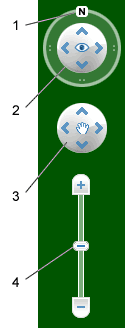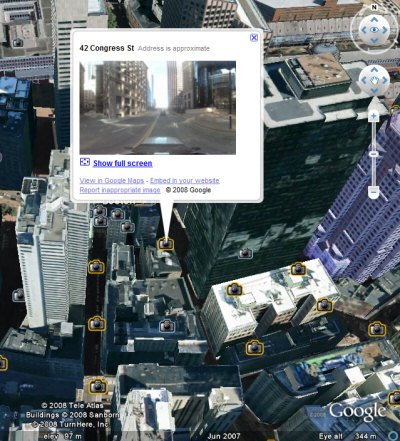 "1. Click the north up button to reset the view so that north is at the top of the screen. Click and drag the ring to rotate your view.
"1. Click the north up button to reset the view so that north is at the top of the screen. Click and drag the ring to rotate your view.2. Use the Look joystick to look around from a single vantage point, as if you were turning your head. Click an arrow to look in that direction or continue to press down on the mouse button to change your view. After clicking an arrow, move the mouse around on the joystick to change the direction of motion.
3. Use the Move joystick to move your position from one place to another. Click an arrow to look in that direction or continue to press down on the mouse button to change your view. After clicking an arrow, move the mouse around on the joystick to change the direction of motion.
4. Use the zoom slider to zoom in or out (+ to zoom in, - to zoom out) or click the icons at the end of the slider. As you move closer to the ground, Google Earth swoops (tilts) to change your viewing angle to be parallel to the Earth's surface. You can turn off this automatic tilt (Tools > Options > Navigation > Navigation controls; Mac: Google Earth > Preferences > Navigation > Navigation controls)."
You can now display the sun by enabling View > Sun or clicking on the sun button from the toolbar. To create time-lapse views of sunsets and sunrises, click on the "play" button and watch the changes.
For some of the imagery, you can see at the bottom of the window an approximation of the date when it was taken. The Street View images from Google Maps are now available in a new Google Earth layer, which is not enabled by default.
Google Earth includes much more models in the 3D buildings layer for cities like: San Francisco, Boston, Orlando, Munich, Zurich. "Google has optimized the loading and performance of 3D buildings. When you first turn on the 3D Buildings layer near a city with models, you'll see simplistic versions of the buildings load up really fast, then they gradually get more solid and load more texture detail," explains the unofficial Google Earth Blog.

Google Earth 4.3 can be downloaded from earth.google.com. Windows users that don't want to install the application using Google Updater can try this direct link. You'll probably notice that the Windows setup is much smaller: the size has been reduced from 12.7 MB to 7.36 MB. Unfortunately, the new version seems to be less stable and it uses more resources, but it's still in beta.
No comments:
Post a Comment